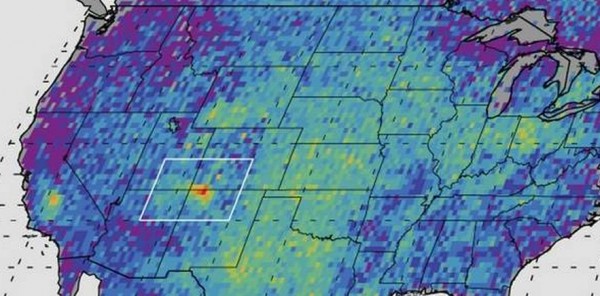NASA, NOAA Investigating Methane Hot Spot at Four Corners
| Arthur Dominic Villasanta | | Apr 20, 2015 12:38 PM EDT |
(Photo : NOAA)
The baffling cloud of methane suspended over the intersection of four U.S. states is being jointly investigated by NASA, the National Oceanic and Atmospheric Administration (NOAA) and researchers from the University of Colorado and the University of Michigan.
The recently discovered methane hot spot is the largest recorded in the U.S. It centers on the Colorado-New Mexico border in La Plata and San Juan counties, respectively. Whether the methane hot spot is dangerous should be uncovered by this study.
Like Us on Facebook
Methane is a natural and manmade greenhouse gas that worsens climate change and smog.
The team is conducting a month long study aimed at getting more detailed data about the persistent but invisible methane cloud or methane bloom detected by scientific instruments as lingering over the common boundaries of New Mexico, Colorado, Arizona and Utah since 2003.
They'll use five different aircraft and two vans equipped with monitors and other equipment to record methane levels in the region. A study released last fall focused on the methane hot spot over the Four Corners region.
Over the next two weeks, seven NASA and NOAA aircraft will take air samples over the region to validate satellite data. Isotope analyses will determine the likely source of the methane.
In addition, two NOAA mobile methane labs will drive around public roads in La Plata and eastern Montezuma counties in New Mexico taking measurements.
Air-quality instruments on the vans detect methane in real time and will reveal spikes in concentration that will be mapped. The results of the ground and airborne methane studies are expected after one year.
The Four Corners area is the No. 1 producer in the U.S. of coalbed methane, a type of natural gas. Natural gas emissions from the Four Corners accounts for 10 percent of the U.S. total, said the Environmental Protection Agency.
At San Juan College at Farmington, New Mexico over the weekend, researchers presented data on the local climate phenomenon and their plans to study it.
The methane hot spot was revealed in a 2014 study by scientists analyzing climate data collected between 2003 and 2009 by the SCIAMACHY (SCanning Imaging Absorption SpectroMeter for Atmospheric CHartographY) instrument aboard the ENVIronmental SATellite or ENVISAT of the European Space Agency.
Eric Kort, a climate expert from the University of Michigan and the lead author of the study, said methane is of particular concern because it is a greenhouse gas but its emissions are much more potent than carbon dioxide.
"That simply means if we increase atmospheric concentrations of methane, it is going to increase temperatures, and that has a global context as well as for local air quality concerns," said Kort.
Methane in the atmosphere has risen in the last 200 years, rising from a constant 700 parts per billion (ppb) from before the Industrial Age to 1800 ppb today.
Researchers said there are many causes for the methane bloom, both natural and man-made.
Some believe natural seepage of methane from geologic deposits in the San Juan Basin might be the cause. Methane leaks from fossil-fuel infrastructure in the same area are another. Fracking is also a culprit. Other sources of methane are wetlands, cattle operations and landfills.
Kort said a recent study of methane leaks in the U.S. showed oil and gas sectors are important contributors, and that methane emissions are consistently underestimated.
©2015 Chinatopix All rights reserved. Do not reproduce without permission
EDITOR'S PICKS
-

Did the Trump administration just announce plans for a trade war with ‘hostile’ China and Russia?
-

US Senate passes Taiwan travel bill slammed by China
-

As Yan Sihong’s family grieves, here are other Chinese students who went missing abroad. Some have never been found
-

Beijing blasts Western critics who ‘smear China’ with the term sharp power
-

China Envoy Seeks to Defuse Tensions With U.S. as a Trade War Brews
-

Singapore's Deputy PM Provides Bitcoin Vote of Confidence Amid China's Blanket Bans
-

China warns investors over risks in overseas virtual currency trading
-

Chinese government most trustworthy: survey
-

Kashima Antlers On Course For Back-To-Back Titles
MOST POPULAR
LATEST NEWS
Zhou Yongkang: China's Former Security Chief Sentenced to Life in Prison

China's former Chief of the Ministry of Public Security, Zhou Yongkang, has been given a life sentence after he was found guilty of abusing his office, bribery and deliberately ... Full Article
TRENDING STORY

China Pork Prices Expected to Stabilize As The Supplies Recover

Elephone P9000 Smartphone is now on Sale on Amazon India

There's a Big Chance Cliffhangers Won't Still Be Resolved When Grey's Anatomy Season 13 Returns

Supreme Court Ruled on Samsung vs Apple Dispute for Patent Infringement

Microsoft Surface Pro 5 Rumors and Release Date: What is the Latest?










